|
||||||||||
|
|
||||||||||
|
||||||||||
|
|
||||||||||

The midget submarines were called the Ko-hyoteki or Type A class. Japan built about 50 of these submersibles and they were differentiated by an HA number or sometimes by the number of the I-type mother submarine that carried it. The two-man crew included a junior officer who served as commander and pilot plus a petty officer who was the engineer operating control valves and adjusting the ballast. The small vessels were 78.5 ft (23.9 m) in length, 6 ft (1.8 m) across and displaced 46 tons while submerged. A total of 224 two-volt electric batteries powered the submarine's 600-hp motor that drove counter-rotating propellers and provided a top speed of 19 knots (22 mph, 35 km/h) submerged. The midget submarine's armament consisted of two 17.7-inch (450-mm) torpedoes loaded one above the other in tubes at the bow. A demolition charge was also carried aboard to destroy and scuttle the vessel if it was in danger of being captured.
One limitation of the midget submarine was its short range, which was less than 20 nautical miles (37 km) at top speed. This drawback prompted Japanese officers to develop the ability to carry the small vessels on the back of larger mother submarines. The mother vessels carried the midget submarines into a target area where the two-man crew would climb aboard before the small submarine was launched on its mission. Following the successful integration of the midget submarine onto the upper hull of a larger vessel, leaders of the program approached Admiral Yamamoto, Commander-in-Chief of the Combined Fleet, in October 1941 about using the small subs during the Pearl Harbor attack then being planned. Yamamoto initially opposed the idea but ultimately approved it despite the misgivings of air staff officers who felt the midget submarines were too likely to alert the Americans to the coming attack.
Following approval of the mission, additional modifications were made to the midget submarines including addition of a propeller guard, a telephone to communicate with the mother sub, and a pneumatically operated steering system. Japan also secretly sent three naval officers disguised as civilians to visit Oahu in November and conduct reconnaissance on the entrance to Pearl Harbor for use by the midget sub crewmen. By 18 November, all plans had been finalized and the midget submarines were mated to their parent vessels for the trip across the Pacific to Hawaii. The five submarines departed on their journey early the next day. They took position off the entrance to Pearl Harbor early on the morning of December 7 where the midget submarines were launched to participate in the attack.

Details of each submarine differ between sources, but the following information is generally agreed upon:
Once launched, the midget submarines were supposed to sneak into Pearl Harbor and launch their torpedo attack around 9 AM during a brief lull between two waves of air strikes. After hopefully scoring deadly strikes on American warships, the submersibles would attempt to escape back out of the harbor and cruise southeast towards Lanai Island. The mother submarines were to wait at this rendezvous point to recover the midget sub crewmen and return to Japan.
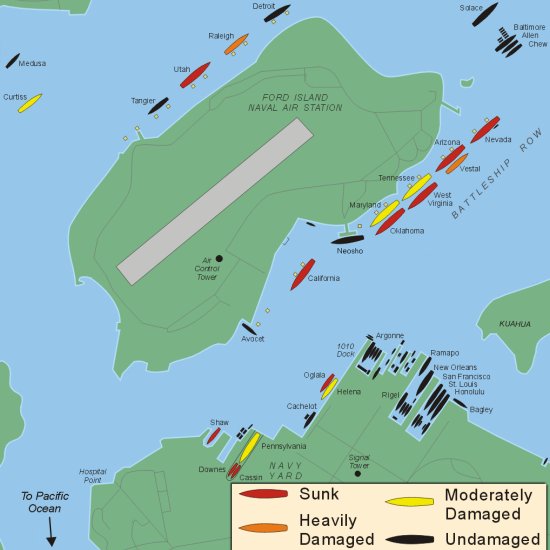
The exact story of each of these vessels after launch is largely a mystery, however, since only one of the ten crewmen survived. The first hint of their presence came around 4 AM when the American minesweeper Condor reported a possible submarine contact in a restricted zone outside the harbor. Though Condor and the destroyer Ward attempted to locate the mysterious vessel, nothing was found. This submarine may have been I-16tou or I-22tou since either could have arrived near the harbor entrance about this time.
The next contact came at 6:30 AM when lookouts aboard the Ward spotted what appeared to be the conning tower of a submarine in an area where no submerged vessel was allowed to operate. A PBY Catalina flying boat also spotted the sub and dropped smoke markers to help the Ward locate it. Within minutes, the Ward had fired its deck guns at the target and struck the conning tower. Ward also sailed overhead while dropping depth charges upon the submarine. Additional depth charges were dropped by the PBY and the midget submarine appeared to have been sunk. Though its identity is unknown for sure, American researchers suspect this vessel was the I-20 midget while Japanese historians believe it to be I-18tou.
Although this incident occurred over an hour before the air strike began, information about the submarine sighting and attack upon it was not passed up to high levels of command until long after the Japanese planes had arrived. Had this information been passed to Admiral Kimmel, Commander of the Pacific Fleet, and General Short, commander of Army installations on Oahu, they might have had sufficient time to prepare defenses that would have reduced the effectiveness of the raid. The first wave of Japanese planes arrived over Oahu shortly before 8 AM and quickly launched devastating bombing and torpedo attacks that decimated the island's airfields and heavily damaged or sunk a number of ships in the harbor.
The next sighting of a midget sub came while the air attack was underway around 8:30. The submersible was spotted northwest of Ford Island almost simultaneously by the destroyer minesweeper Zane, the minelayer Breese, and the seaplane tender Curtiss near the berth of the repair ship Medusa. Curtiss opened fire on the vessel and was quickly joined by the Medusa, the tender Tangier, and the destroyer minewseeper Perry. The destroyer Monaghan was also steaming nearby attempting to reach the sea when she spotted the submarine's conning tower and went to flank speed to ram the vessel.
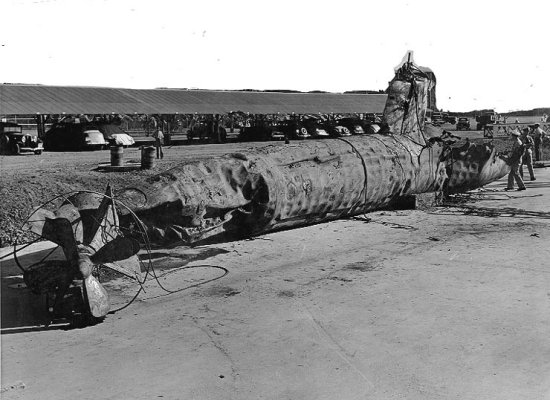
The midget submarine fired one of its torpedoes at Curtiss but missed and struck a dock instead. The force of the torpedo launch also caused the submarine to break the surface where shells from at least one of the attacking vessels struck it and probably killed its commanding officer. With Monaghan rapidly bearing down upon it, the submarine fired its second torpedo at the approaching destroyer, but this shot passed the ship and exploded against the shore. As Monaghan rammed the submersible, the midget sub was pushed down into the floor of the harbor until the destroyer loosed a pair of depth charges that blew the sub back to the surface. Now heavily damaged, the midget submarine finally sank.
It is believed this vessel was most likely the submarine launched by I-22 since the tattered sleeve of a full lieutenant was found aboard, and this was the only midget commanded by someone of that rank. The wreck was raised about two weeks after the attack but was so badly damaged that it was not explored. The propeller screws and parts from the forward hull were salvaged but the rest of the sub was buried as landfill inside the submarine dock at Ford Island during the dock's reconstruction later in the war. The hulk was uncovered again in 1952 but was so badly corroded by chlorine gas from the electrical batteries that it was again reburied at the same location. The remains of the crew have never been removed.

By now, just about every ship in Pearl Harbor was claiming submarine sightings both real and imagined. The most likely actual sub encounter came near the mouth of the harbor where the light cruiser St. Louis was moving down the channel at high speed to escape out to sea. Shortly after 10 AM, the cruiser was fired upon by two torpedoes that missed and struck coral on the shoreline. St. Louis then spotted the conning tower of a submarine and commenced firing upon it. The destroyer Blue was also nearby and detected a sound contact that was attacked with depth charges.
Other ships also dropped depth charges on several possible metallic contacts near the harbor entrance throughout the morning and afternoon and often reported oil slicks rising to the surface. It is unknown how many of these were actual midget submarines, but these would not have created oil slicks since they were battery powered instead of using diesel fuel like conventional submarines. At least one vessel is known to have been sunk in this area, however, since the wreckage of a midget submarine was discovered about 75 ft (23 m) deep in Keehi Lagoon just outside the harbor entrance in June 1960.
The hulk was raised a few weeks later but the hatch atop the conning tower was open and no human remains were aboard. A shoe, papers, and other debris found inside led researchers to suspect this was the submarine launched from I-18. The sub still had its two torpedoes aboard, so it couldn't have been the vessel that attacked the St. Louis. The forward section of the hull, containing the still dangerous torpedo armament, was removed for disposal at sea. The remainder was returned to Japan and attached to a newly fabricated forward hull for display at the Maritime Self-Defense Force Officer Candidate School in Eta Jima.
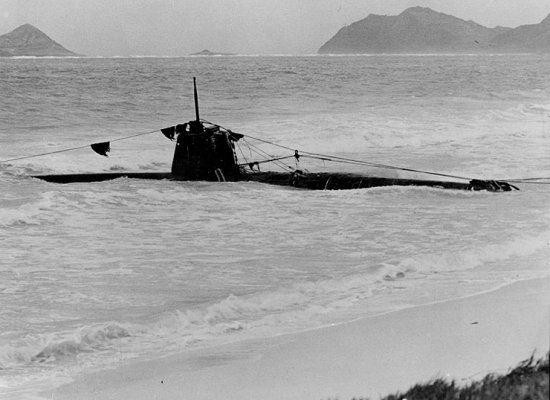
HA-19 commanded by Kazuo Sakamaki was the final midget sub launched and continued its mission in spite of the gyroscope problems described earlier. The crew tried fruitlessly to enter the harbor around 8 AM but ran aground on a reef causing damage to the lower torpedo tube and rudder. The grounded vessel was spotted and fired upon by the destroyer Helm but the crew managed to shift weight within the sub and slipped back off the reef.
Their troubles only continued to worsen when the submersible's batteries began leaking toxic chlorine gas that knocked the men unconscious. As they came to, HA-19 ran aground again but they managed to free the vessel a second time. The damage the vessel had sustained, however, made it impossible to control and HA-19 drifted aimlessly as depth charges fell around it. Having spent hours unsuccessfully trying to complete their mission, the men purposefully ran the sub aground a final time before lighting the fuse to the demolition charge and leaping into the sea. Kiyoshi Inagaki apparently drowned but Sakamaki was knocked unconscious by the pounding surf. He later washed ashore only to be captured as the first prisoner of war of the conflict.
HA-19 had come ashore on Waimanalo Beach near Bellows Field on the southeast side of Oahu. The scuttling charge failed to detonate and the submarine was captured intact. Damaged portions of the vessel were replaced using parts salvaged from the submarine sunk by the Monaghan, and HA-19 spent the war as a traveling display encouraging Americans to buy War Bonds. HA-19 was later placed on display at Key West, Florida, and currently resides at the National Museum of the Pacific War in Fredericksburg, Texas.
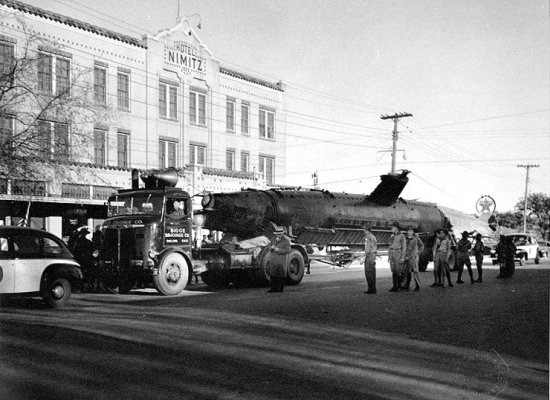
While these four midget submarines have been accounted for, the fate of the fifth still remains a mystery. This sub is believed to be that launched from I-16. One clue about its status was a radio transmission received by the mother sub at 10:40 PM on December 7 stating the code words for "Success, success, success." It is not certain the message came from the I-16 midget, but another transmission indicating that the sub was "unable to navigate" that was received at 12:51 AM is believed to have been sent by that submarine's commander.
A controversial recent theory about the missing midget sub is based on one of the photos snapped by a Japanese plane during the attack. During the 1990s, a group of researchers performed a detailed study of this photo and found evidence that a midget submarine may have successfully penetrated the harbor and accomplished its primary mission of attacking ships on Battleship Row. The photo, shown below, was taken from a Nakajima B5N2 "Kate" torpedo bomber shortly after the first wave of air attacks had begun. Clearly visible are the tracks of several torpedoes headed towards the ships moored along Battleship Row. One region of the photo in particular also shows a curious black rectangular object that was the subject of the investigation. A description of the analysis performed on the image is described in a 1999 article from the U.S. Naval Institute (link no longer available).
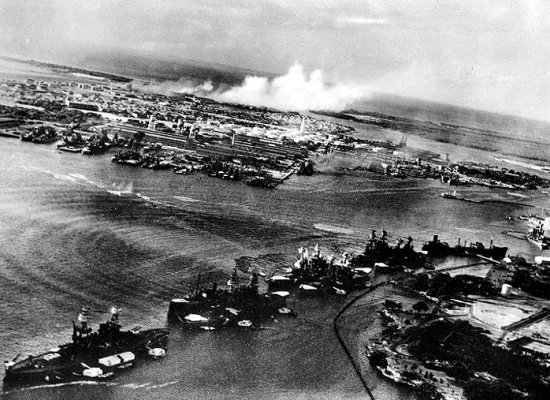
The key elements of the photo are further highlighted below. The researchers believe this rectangular object is attached to a longer linear object, such as the conning tower of a submarine attached to its hull. This rectangular object also appears to be surrounded by a white region like a wake of water created when it broke through the surface. The battleships Oklahoma and West Virginia took the brunt of the torpedo attack and had already been struck by the time this photo was taken as indicated by concussion waves spreading from the vessels. Two of these tracks appear to converge near the object in question. One of the tracks lines up with a spout of water rising above the deck of the West Virginia shortly after the ship had been hit. The second track is headed towards the Oklahoma.
Also noteworthy is a set of three sprays rising into the air behind the rectangular object. These sprays are often referred to as a "rooster tail." This spray pattern may have been created by counter-rotating propellers bobbing up and down through the surface of the water, as though they were attached to an object pitching up and down. The researchers believe such a pitching motion would have been induced by the concussion waves impacting against the object in question. The photo analysts went on to take measurements of the object and estimated it to be approximately 60 ft (18.2 m) in length and 4 ft (1.25 m) tall. These measurements are on the same order of magnitude as a Japanese midget submarine.
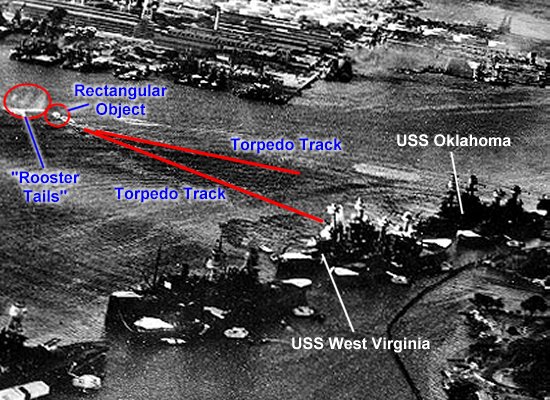
Based on these measurements and the behavior of the object under the influence of the concussion waves, the researchers concluded that a midget submarine did enter Pearl Harbor and launched its torpedoes into Battleship Row. The first struck the USS West Virginia sending up the large spout of water. The submarine then turned towards the USS Oklahoma and fired its second torpedo. As the submarine was turning towards the harbor entrance to escape, it was struck by a series of concussion waves that caused it to break the surface of the water and pitch vertically. This pitching motion exposed the vessel's counter-rotating propellers causing the rooster tail spray formation.
However, other historians and analysts disagree with this scenario. One good rebuttal to the original research was published in World War II Magazine in 2002 (link no longer available). Perhaps most significant of the author's findings was that the mysterious object in question may only be an imperfection, such as a piece of lint, on the original photograph. He also points out that the rooster tail spray could have just as easily been created by the counter-rotating propellers of an aerial torpedo pitching up and down as it entered the water rather than a submarine. Furthermore, it seems illogical that a midget submarine would have risked being in that location of the harbor at the same time Japanese aircraft were dropping their torpedoes to attack Battleship Row. One of the aerial torpedoes could have easily hit the midget submarine instead of its intended target. A map obtained from the captured HA-19 also indicates that none of the midget submarines were supposed to reach that area until at least 10 AM, a full two hours after the photo was taken, to avoid interference with the aerial torpedo attack. (Another detailed rebuttal to the midget submarine theory can be found in this 2005 letter to Naval History.)
Even more conclusive evidence to prove or disprove this theory may exist with the midget submarines themselves. Japan confirmed that five of the vessels participated in the attack and three have already been recovered. HA-19 was captured with its torpedoes still aboard since the sub was never able to enter the harbor. Raised after the attack was the submarine sunk by the Monaghan that had fired its torpedoes harmlessly into the shoreline and not into any of the ships along Battleship Row. The submarine discovered outside the entrance to the harbor in 1960 was also raised with its torpedoes still aboard.
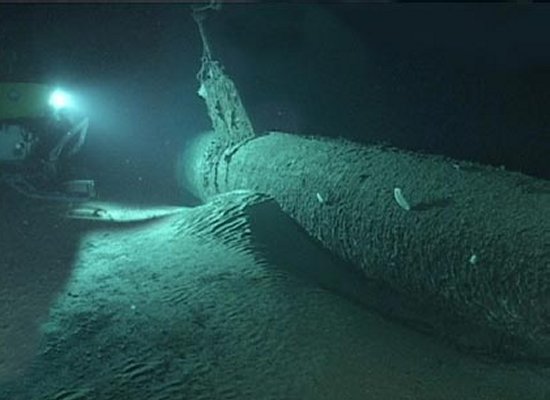
The most recent news of the midget submarines came in August 2002 when researchers from the Hawaii Undersea Research Laboratory (HURL) finally located the submarine sunk by the Ward. This submarine had been the subject of search efforts for years by such well-known personalities as Robert Ballard. Considering that it was depth charged by the Ward and a Catalina flying boat, the midget is in remarkably good condition and the only visible damage is shell and shrapnel holes created by the Ward's guns. Pictures and video clips of the discovery are available at the HURL site. Like HA-19 and the submarine raised in 1960, this sub's torpedoes are also still clearly onboard since the vessel never had the chance to enter the harbor in the first place.
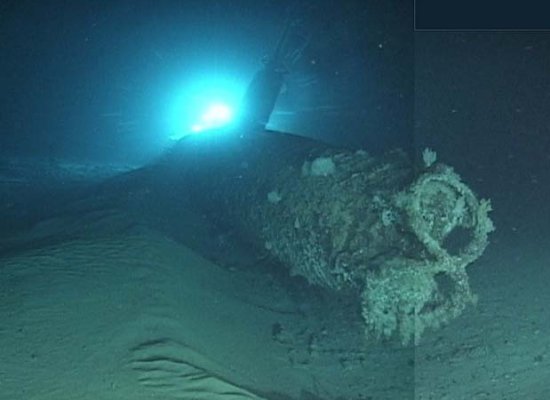
Only one of the midgets remains unaccounted for, so we do not yet know whether its torpedoes are still aboard.
Nonetheless, we do know the St. Louis was attacked by an apparent midget submarine that fired its torpedoes
as the American cruiser was traveling through the harbor entrance. Given this information, none of the midget subs
could have launched an attack on Battleship Row. Until the final submarine is discovered, however, the mystery of
whether it could have successfully accomplished its mission may be impossible to solve.
- answer by Joe Yoon, 23 July 2006
Update!
New research continues into the mystery of the fifth midget submarine, the one launched from I-16. The wreckage of this vessel is believed to have been found outside the harbor by a team of researchers from HURL in March 2009. Though unconfirmed, theories speculate the midget submarine may have successfully completed a torpedo attack on the battleship Oklahoma around 8 AM. A second torpedo was perhaps fired into the West Virginia or Arizona. However, this weapon could have failed to detonate given evidence that an unexploded torpedo with a larger warhead than those launched by plane was recovered from the harbor floor after the attack.
The theory goes on to postulate that this sub was observed trying to escape the harbor around 9 AM by the minesweeper Bobolink. The attempt failed since an anti-submarine net at the harbor entrance was closed. I-16tou perhaps instead turned into the West Loch and may have remained submerged in a nearly deserted part of the harbor called Walker Bay until nightfall. The sub might have surfaced at night, possibly accounting for the one or two radio messages the submarine is suspected to have sent. The midget submarine may have ended its mission here since damage suggests the crew set off the scuttling charge.
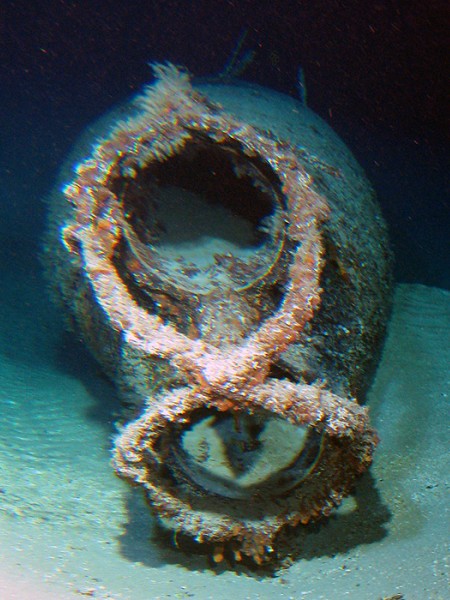
Much of this theory is based on research at an excellent site called I-16tou.com. The authors discuss the fifth submarine and the likelihood it successfully participated in the Pearl Harbor attack. The site goes on to present evidence of I-16tou being discovered in Walker Bay in 1944 during a salvage operation following an explosion that destroyed several landing craft being prepared to invade the Mariana Islands. In the course of clearing the wreckage from this explosion, the authors speculate the remains of I-16tou were found, broken up, and disposed of outside the harbor. This chain of events may explain why the midget submarine wreckage was found in three major sections surrounded by debris believed to be dumped from the West Loch Disaster.
Nevertheless, firm evidence that any of the midget submarines succeeded at Pearl Harbor remains elusive and the
true identity of the newly discovered wreckage is still debated.
- answer by Jeff Scott, 20 February 2012
Read More Articles:


|
Aircraft | Design | Ask Us | Shop | Search |

|
|
| About Us | Contact Us | Copyright © 1997-2023 | |||
|
|
|||